
Kamkikaze: To Die For an Emperor
 |
The movie starts by talking about the Kublai Khan's intended invasions of Japan. Twice the fleet reached Japan, and twice they were destroyed by hurricanes. The people called the storm winds “heaven sent.”
 |
1944 and Japanese forces are in retreat.
 |
“Japan's march of conquest begins in 1931.”
 |
The film says there is a belief that the Japanese planted the bomb that blew up the railway themselves as an excuse for their aggression.
 |
The League of Nations condemns Japan's actions, so Japan just leaves the League of Nations.
 |
The Japanese government ends up dominated by the military.
 |
Peking is taken and Nanking is sacked.
 |
“The Rising Sun flies over Eastern Asia.”
 |
The attack on Pearl Harbor.
 |
As of 1944, though, the Japanese are retreating, facing the might of the American armed forces.
 |
Off the Philippines, a Japanese plane crashes into the carrier Franklin. This was the first kamikaze attack.
 |
“Suicide is not alien to the Japanese. They honor suicide for its purity. To them it bears no stigma.
 |
In the military, every member feels he owes his life to his country and his Emperor.
 |
Fighting on the Solomon islands. The film explains how, in 1943, some Japanese planners were considering the use of “human torpedoes.”
 |
Japanese troops strap satchels of explosives onto their bodies and jump against the tanks to destroy them. This doesn't stop the American advance, though.
 |
June, 1944. Marines land on Saipan.
 |
On the same day, B-29s based in China begin their attacks on Japan itself.
 |
The “Great Marianas Turkey Shoot.” The Japanese lose three carriers and over 400 planes.
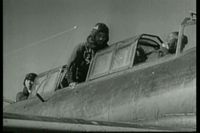 |
The film then explains how the training of Japanese pilots has changed, and how there are fewer experienced pilots. The training that there is has been cut back severely, and many aspects formerly covered, like navigation, are left out.
 |
After the fall of Saipan, Tokyo High Command order the use of “human bullets” to cease. There had been a program for a short time that they hoped would make better pilots, but it failed.
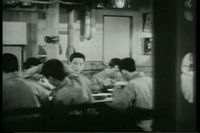 |
Mid-Oct (1944), and the Japanese have lost more than 5000 pilots since the start of the year. US forces are preparing to attack the Philippine Islands.
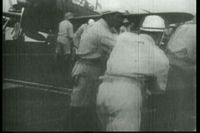 |
Operation Sho, a three-pronged attack against the US invasion fleet, is planned. Japanese carriers will be used as decoys to get some of the American force split off from the main force.
 |
A voluntary special attack unit is formed to meet the US invasion fleet.
 |
Oct. 21st, the first of the actual planned kamikaze take off. They can't find their targets and return, but US fighters attack their planes while on they are on the ground.
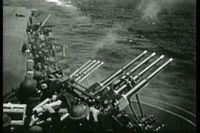 |
The Japanese launch a traditional air attack on the US ships and lose a hundred planes in the process, sinking a carrier and another ship.
 |
One part of the Japanese fleets ends up engaging part of the US fleet and suffer major losses, not counting losses that already happened due to US submarine and plane attacks.
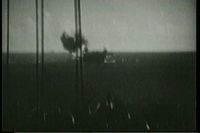 |
Then the kamikazes attack again and have some success. Observers sent with them tend to exaggerate the damage, though. The film says the actual damage was about 10% of what was actually claimed.
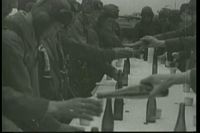 |
The film then explains some of the ceremonies involved in the kamikaze program.
 |
The kamikaze are taking both a physical toll and a toll on US morale.
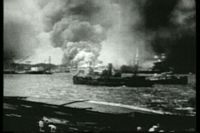 |
The kaitens sink an oil ship at Ulithi.
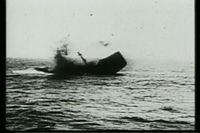 |
A Japanese convoy is destroyed by US planes.
 |
Japanese air fields on Luzon are bombed. US carriers now carry more planes to help in their defense, and more destroyers are produced to help protect the carriers, both in response to the kamikaze attacks.
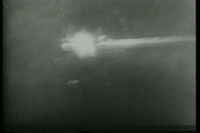 |
The US is sinking 70% of Japanese shipping in the area around the Philippines/Luzon/etc.
 |
Jan. 12, 1945, the last organized kamikaze raid in the area. The raids have cost the lives of 1200 pilots.
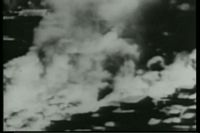 |
March 9/10. B-29's stage their massive firebombing raid on Tokyo, with the loss of around 100,000 Japanese lives.
 |
Japanese bombers on a suicide mission. Only half reach the target area, probably due to lack of fuel. One hits an aircraft carrier but the plane has so little fuel on board it doesn't even explode.
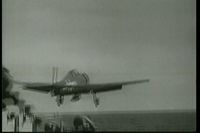 |
As the American fleet gets to about a hundred miles from Japan it's attacked by both regular pilots and kamikaze. Then a flight of bombers carrying the ohka bomb (baka bomb) approach the fleet and all are shot down. The Japanese believe they have sunk five carriers, but all five were damaged and withdrawn for repairs.
Bombardment of Okinawa begins.
A large kamikaze force attacks the US ships at Okinawa. (One of the problems in the video is its tendency to reuse short clips, so scenes such as this one might be from the Okinawa battle, and, on the other hand, could be from something else.)
The Yamato and five other ships are sunk in a suicide task force that was supposed to attack the US transports at Okinawa.
A new Army and Imperial HQ is built in the caves of Honshu, away from Tokyo. This was supposed to be where the military would issue its commands once the invasion of Japan itself had begun.
Schoolchildren in Japan are drilled in battle techniques, and all citizens are now considered special attack force members.
The atomic bombing of Hiroshima. The film then notes the bombing of Nagasaki and the very last kamikaze mission against the US, just around the time the Emperor announced the surrender of Japan.
Main Index
Japan main page
Japanese-American Internment Camps index page
Japan and World War II index page
|
|